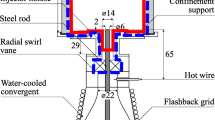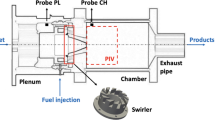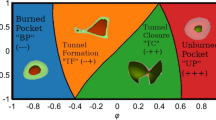Abstract
This paper presents a numerical study of head on quenching (HOQ) (an extreme case of flame/wall interactions) as a source of sound generation, which in turn can trigger combustion instabilities and enhanced noise levels. High-fidelity numerical simulations are performed to investigate the impact of wall temperature, high chamber pressures and Lewis number of the fuel on the noise generation. It is demonstrated by theory and simulations that the underlying mechanism of sound generation is flame surface destruction (flame annihilation). Special emphasis is put on chemical modeling where simple and complex mechanisms were compared: it is shown that simple chemistry simulations overestimate the generated pressure peaks due to a too fast extinction of the heat release rate compared to the complex scheme. In contrast to the simple mechanism, the complex scheme accounts for minor and intermediate species production and destruction which slows down the extinction process and thus lead to a lower sound level. This effect has to be taken into account, especially in the context of Large Eddy Simulation (LES) of combustion instabilities and combustion noise where simple chemical descriptions are often employed.













Similar content being viewed by others
References
Dreizler, A., Böhm, B.: Advanced laser diagnostics for an improved understanding of premixed flame-wall interactions. Proc. Combust. Inst. 35, 37–64 (2015). doi:10.1016/j.proci.2014.08.014
Gruber, A., Sankaran, R., Hawkes, E.R., Chen, J.: Turbulent flame–wall interaction: A direct numerical simulation study. J. Fluid Mech. 658, 5–32 (2010). doi:10.1017/S0022112010001278
Hocks, W., Peters, N., Adomeit, G.: Flame quenching in front of a cold wall under two-step kinetics. Combust. Flame 41, 81–99 (1981). doi:10.1016/0010-2180(81)90049-3
Wichman, I., Bruneaux, G.: Head on quenching of a premixed flame by a cold wall. Combust. Flame 103(4), 296–310 (1995). doi:10.1016/0010-2180(95)00100-X
Xavier, P., Ghani, A., Mejia, D., Miguel-Brebion, M., Bauerheim, M., Selle, L., Poinsot, T.: Experimental and numerical investigation of flames stabilised behind rotating cylinders: interaction of flames with a moving wall. J. Fluid Mech. 813, 127–151 (2017)
Lieuwen, T.: Unsteady Combustor Physics. Cambridge University Press (2012)
Poinsot, T., Veynante, D.: Theoretical and Numerical Combustion, 3rd edn, (www.cerfacs.fr/elearning) (2011)
Bruneaux, G., Akselvoll, K., Poinsot, T., Ferziger, J.: Flame-wall interaction in a turbulent channel flow. Combust. Flame 107(1/2), 27–44 (1996). doi:10.1016/0010-2180(95)00263-4
Popp, P., Baum, M.: An analysis of wall heat fluxes, reaction mechanisms and unburnt hydrocarbons during the head-on quenching of a laminar methane flame. Combust. Flame 108(3), 327–348 (1997). doi:10.1016/S0010-2180(96)00144-7
Westbrook, C.K., Adamczyk, A.A., Lavoie, G.A.: A numerical study of laminar flame wall quenching. Combust. Flame 40, 81–99 (1981). doi:10.1016/0010-2180(81)90112-7
Ihme, M.: Combustion and engine-core noise. Ann. Rev. Fluid Mech 49, 277–310 (2017). doi:10.1146/annurev-fluid-122414-034542
Franzelli, B., Riber, E., Sanjosé, M., Poinsot, T.: A two-step chemical scheme for Large-Eddy Simulation of kerosene-air flames. Combust. Flame 157(7), 1364–1373 (2010). doi:10.1016/j.combustflame.2010.03.014
Ghani, A., Poinsot, T., Gicquel, L., Staffelbach, G.: Les of longitudinal and transverse self-excited combustion instabilities in a bluff-body stabilized turbulent premixed flame. Combust. Flame 162, 4075–4083 (2015)
Hermeth, S., Staffelbach, G., Gicquel, L., Poinsot, T.: LES evaluation of the effects of equivalence ratio fluctuations on the dynamic flame response in a real gas turbine combustion chamber. Proc. Combust. Inst. 34(2), 3165–3173 (2013). doi:10.1016/j.proci.2012.07.013. http://www.sciencedirect.com/science/article/pii/S1540748912003045
Ghani, A., Gicquel, L., Poinsot, T.: Acoustic analysis of a liquid fuel swirl combustor using dynamic mode decomposition. In: ASME Turbo Expo 2015: Turbine Technical Conference and Exposition, pp. 1–9. American Society of Mechanical Engineers (2015)
Ghani, A., Poinsot, T., Gicquel, L., Müller, J.D.: Les study of transverse acoustic instabilities in a swirled kerosene/air combustion chamber. Flow Turb. Combust. 96(1), 207–226 (2016)
Talei, M., Brear, M.J., Hawkes, E.R.: Sound generation by laminar premixed flame annihilation. J. Fluid Mech. 679, 194–218 (2011). doi:10.1017/jfm.2011.131
Brear, M.J., Nicoud, F., Talei, M., Giauque, A., Hawkes, E.R.: Disturbance energy transport and sound production in gaseous combustion. J. Fluid Mech. 707, 53–73 (2012). doi:10.1017/jfm.2012.264
Candel, S., Durox, D., Schuller, T.: Flame interactions as a source of noise and combustion instabilities. In: 10th AIAA/CEAS Aeroacoustics Conference - AIAA 2004-2928, pp. 1444–1454 (2004)
Blanchard, M., Schmid, P. J., D.S., Schuller, T.: Pressure wave generation from perturbed premixed flames. J. Fluid Mech. 797, 231–246 (2016). doi:10.1017/jfm.2016.268
Strahle, W.C.: On combustion generated noise. J. Fluid Mech. 49, 399–414 (1971). doi:10.1017/S0022112071002167
Swaminathan, N., Xu, G., Dowling, a.P., Balachandran, R.: Heat release rate correlation and combustion noise in premixed flames. J. Fluid Mech. 681, 80–115 (2011). doi:10.1017/jfm.2011.232
Lighthill, M.J.: On sound generated aerodynamically: I. general theory. Proc. R. Soc. Lond 211(1107), 564–587 (1952). doi:10.1098/rspa.1952.0060
Crighton, D.G., Dowling, A.P., Williams, J.E.F., Heckl, M., Leppington, F.: Modern Methods in Analytical Acoustics, Lecture Notes, vol. 1sd ed. Springer Verlag, New-York (1992)
Colin, O., Ducros, F., Veynante, D., Poinsot, T.: A thickened flame model for large eddy simulations of turbulent premixed combustion. Phys. Fluids 12(7), 1843–1863 (2000). doi:10.1063/1.870436
Poinsot, T., Lele, S.: Boundary conditions for direct simulations of compressible viscous flows. J. Comput. Phys. 101(1), 104–129 (1992). doi:10.1016/0021-9991(92)90046-2
Lu, T., Law, C.K.: A criterion based on computational singular perturbation for the identification of quasi steady state species: A reduced mechanism for methane oxidation with no chemistry. Combust. Flame 154, 761–774 (2008). doi:10.1016/j.combustflame.2008.04.025
Bodenstein, M.: Eine Theorie der photochemischen Reaktionsgeschwindigkeiten. Z. Phys. Chem. 85(329), 0022–3654 (1913)
Warnatz, J.: The mechanism of high temperature combustion of propane and butane. Combust. Sci. Tech. 34, 177 (1983). doi:10.1080/00102208308923692
Hawkes, E.R., Chen, J.H.: Direct numerical simulation of hydrogen-enriched lean premixed methane-air flames. Combust. Flame 138(3), 242–258 (2004). doi:10.1016/j.combustflame.2004.04.010
Dinkelacker, F., Manickam, B., Muppala, S.: Modelling and simulation of lean premixed turbulent methane/hydrogen/air flames with an effective lewis number approach. Combust. Flame 158, 1742–1749 (2011). doi:10.1016/j.combustflame.2010.12.003
Jimenez, C., Haghiri, A., Brear, M.J., Talei, M., Hawkes, E.: Sound generation by premixed flame annihilation with full and simple chemistry. Proc. Combust. Inst. 35, 3317–3325 (2015)
Acknowledgments
The research leading to these results has received funding from the European Research Council under the European Union’s Seventh Framework Programme (FP/2007-2013)/ERC Grant Agreement ERC-AdG 319067-INTECOCIS. This work was granted access to the high-performance computing resources of IDRIS under the allocation x20162b7036 made by GENCI. Cerfacs is greatly acknowledged for their support on the AVBP code. A.G. would like to thank O. Schulz, Dr. P. Xavier and Dr. C. Kraus for fruitful discussions.
Author information
Authors and Affiliations
Corresponding author
Ethics declarations
Conflict of interests
The authors declare that they have no conflict of interest.
Rights and permissions
About this article
Cite this article
Ghani, A., Poinsot, T. Flame Quenching at Walls: A Source of Sound Generation. Flow Turbulence Combust 99, 173–184 (2017). https://doi.org/10.1007/s10494-017-9810-5
Received:
Accepted:
Published:
Issue Date:
DOI: https://doi.org/10.1007/s10494-017-9810-5




